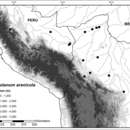Description
provided by Phytokeys
Herb or vigorous, weak-stemmed shrub 0.2–1.5 m tall. Stems angled, sparsely to densely pubescent with simple, translucent, uniseriate 3–8-celled trichomes 0.8–2 mm long with glandular tips; new growth densely pubescent with spreading glandular trichomes like those of the stem. Sympodial units difoliate, not geminate. Leaves simple, 2.6–13 cm long, 0.8–5 cm wide, ovate to broadly ovate, membranous; adaxial surface glabrous; abaxial surface paler or tinged with purple, sparsely pubescent with simple uniseriate trichomes like those of the stem restricted to the veins; primary veins 5–7 pairs; base acute to cuneate and decurrent on the petiole; margins variable in shape from entire to undulate to shallowly lobed; apex acute-acuminate; petiole 0.5–5.0 cm long, sparsely to densely pubescent with glandular trichomes like those of the stems. Inflorescences 2.0–3.5 cm long, lateral and internodal, simple, with 3–8(9) flowers, sparsely to densely pubescent with spreading glandular trichomes like those of the stem; peduncle 1.0–2.4 cm long; pedicels 0.5–0.7 cm long, ca. 0.3 mm in diameter at the base and 0.4 mm at apex, straight and spreading, articulated at the base; pedicel scars unevenly spaced 1.0–2.5 mm apart. Buds ellipsoid, the corolla strongly exerted from the calyx tube long before anthesis. Flowers 5-merous, all perfect; calyx tube ca. 1 mm long, shallow, the lobes 0.2–0.5 mm long, triangular with acute apices, sparsely to densely pubescent with glandular trichomes like those of the stem; corolla 8–12 mm in diameter, stellate, white with a purple-yellow or yellow-green central eye at the base, lobed 2/3 to the base, the lobes ca. 3.5–4.0 mm long, 1.0–1.5 mm wide, strongly reflexed at anthesis, later spreading, densely pubescent abaxially with glandular trichomes like those of the stems, glabrous adaxially; filament tube 1.0–1.2 mm long; free portion of the filaments slightly unequal in length, the lower two ca. 1.5 mm long, the upper three ca. 1.0–1.2 mm long, sparsely pubescent with simple uniseriate 1–3-celled trichomes on the side facing the ovary; anthers 3.0–4.0 mm long, 0.8–0.9 mm wide at base and 0.5–0.6 mm wide at apex, cylindrical, narrowing towards the apex, yellow, poricidal at the tips, the pores lengthening to slits with age; ovary ellipsoid, glabrous; style 4–5.7 mm long, exerted 2.0–3.0 mm beyond the anther cone, densely pubescent up to 2/3 of the length with 1–6-celled simple uniseriate trichomes, these longer at the base and becoming gradually shorter towards the middle; stigma clavate, minutely papillate. Fruit a globose berry, 3.5–7.0 mm in diameter, green, turning black when ripe; fruiting peduncle 2.0 cm long; fruiting pedicels 1.0–2.0 cm long, ca. 0.5 mm in diameter at the base and 0.6 mm at apex, strongly recurved; fruiting calyx lobes appressed to the berry, the tips not reflexed. Seeds 35–45 per berry, ca. 0.8 mm long, ca. 0.6 mm wide, flattened-reniform, narrowing towards one end, yellow, the sub-laterally positioned hilum positioned towards the narrower end, the testal cells pentagonal in outline; stone cells few per fruit.
- license
- cc-by-3.0
- copyright
- Tiina Särkinen, Paúl Gonzáles, Sandra Knapp
- bibliographic citation
- Särkinen T, Gonzáles P, Knapp S (2015) Four new non-spiny Solanum (Solanaceae) species from South America PhytoKeys (44): 39–64
- author
- Tiina Särkinen
- author
- Paúl Gonzáles
- author
- Sandra Knapp
Distribution
provided by Phytokeys
In lowland Bolivia and Peru; in lowland moist rain forest in sandbanks and river margins, tree fall gaps, and in disturbed sites near housing and fields in open, sandy soil, with occasional records from seasonally dry semi-deciduous forests with Hura crepitans L. (Euphorbiaceae), Gallesia integrifolia (Spreng.) Harms (Phytolaccaceae), Bougainvillea modesta Heimer (Nyctaginaceae), and Anadenanthera colubrina (Vell.) Brenan (Amaranthaceae); most commonly associated with lowland rain forest pioneer species, including Salix humboldtiana Willd. (Salicaceae), Tessaria integrifolia Ruiz & Pav. (Asteraceae), Cecropia spp. (Urticaceae), Calliandra sp. (Fabaceae), Neea spp. (Nyctaginaceae), Garcinia spp. (Clusiaceae), and Jacaratia digitata (Poepp. & Endl.) Solms (Caricaceae), and annual herbs such as Glinus radiatus (Ruiz & Pav.) Rohrb. (Molluginaceae), Physalis angulata L., Physalis peruviana L., and Solanum americanum Mill. (Solanceae); 0–600 (1,300) m elevation.
- license
- cc-by-3.0
- copyright
- Tiina Särkinen, Paúl Gonzáles, Sandra Knapp
- bibliographic citation
- Särkinen T, Gonzáles P, Knapp S (2015) Four new non-spiny Solanum (Solanaceae) species from South America PhytoKeys (44): 39–64
- author
- Tiina Särkinen
- author
- Paúl Gonzáles
- author
- Sandra Knapp

